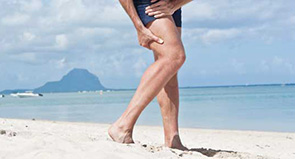
Hamstring strains happen when any of your hamstrings muscles or its tendons is stretched beyond what it can withstand or torn when substantial stretching of the muscle occurs. Hamstring strains are fairly common in sports activities requiring the athlete to forcefully run or jump. A hamstring strain is also called a pulled hamstring or hamstring tear. An inflamed hamstring tendon is called hamstring tendonitis.
Your hamstrings or hamstring muscles are located at the back of your thigh. You have three hamstring muscles. Together, they help bend your knees as you lie face-down; lift your foot toward your back (without bending your hip); and help you walk normally.
Causes of hamstring strains
Hamstring strain occurs when any of your hamstrings or its tendon is overstretched, overused, or overexerted during a sports or recreational activity such as sprinting, kicking or jumping. Exercising improperly, such as increasing the duration or intensity of your workout too much or too soon, may also lead to hamstring strains.
The treatment plan for hamstring injuries consists of a biomechanical evaluation of the spine, pelvis, knee, ankle, and foot. The foot should be checked for overpronation.
Depending on the severity of your hamstring strain, you may be receiving a combination of the following;
- Recommend rest
- Ice and or heat application
- Chiropractic manipulation to all subluxated joints
- Deep tissue massage therapy
- Recommend crutches / Crutch walking training
- Gentle range of motion exercises
- Gentle stretching (manual or active)
- Progressive strengthening exercises
- Work or sports-related strengthening program
- Patient education
- About your condition
- Precautions to observe
- Activity or work modification
- Injury prevention
- Rehabilitation program
With appropriate management, patients with minor hamstring strains can usually recover in one to three weeks. With larger tears, recovery may take four to six weeks or longer depending on the severity. In cases of a complete rupture of the hamstring muscle, surgery may be considered with intensive rehabilitation to follow. Return to sport or activity may then take 6 months or longer.
Stretch of the Month
Bent Leg Hamstring Stretch

Bent leg hamstring stretch on the back targets the muscle fibres closer to the hip whereas the straight leg hamstring stretch targets the fibres nearer the knee.
- Lie on your back and pull the leg over keeping the knee very slightly bent until a gentle stretch is felt at the back of the leg.
- Again this should not be painful.
- Perform 3 sets of 10 seconds once or twice a day.
Towards Wellness

Companionship can help prevent illness and even add years to your life, while isolation and loneliness can trigger symptoms of depression. Caring for a living animal can help make you feel needed and wanted, and take the focus away from your problems, especially if you live alone. Most dog and cat owners talk to their pets, some even use them to work through their troubles. And nothing beats loneliness like coming home to a wagging tail and wet kisses.

